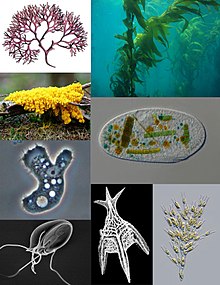
Back Protis Afrikaans Protisten ALS Protista AN प्रोटिस्ट् ANP طلائعيات Arabic طلائعيات ARZ প্ৰটিষ্টা Assamese Protista AST İbtidailər Azerbaijani پروتیستلر AZB

Protists are single-celled eukaryotes (which are organisms with a nucleus). The term Protista was first used by Ernst Haeckel in 1866.[1] The protists are not a natural group, or clade, since they have no common origin. Like algae or invertebrates, they are often grouped together for convenience.
The term "protist" includes microorganisms from several distantly related phyla. Some are autotrophic (which means they make their own food by photosynthesis), and others are heterotrophic (which means they eat organic material).
Most protists are very small. They are made up of one or a few cells at most – they are microscopic and usually invisible to the naked eye. Some algae are protists, if they are single-celled. Many protists are part of the plankton and are very important for the ecosystem. The cells found in protists may be extremely complex, and are often little understood. It is now possible to do DNA sequencing, and a number of protists have been analysed. The results show that the Protista is not a monophyletic group. It is paraphyletic, and not a single clade. The taxonomy of the Protista is therefore rather confused.
Some protists cause diseases. Plasmodium falciparum causes malaria; sleeping sickness is also caused by a protist.
An example of a single celled organism in the protist kingdom is the Paramecium or "slipper animalcule." The Paramecium moves using its small, hair-like fibers called cilia, and eats using the cilia to sweep the food into its food vacuole. Other protists can be amoebas, which move by extending pseudopods and flowing into them, or flowing around food particles and engulfing them.
| Nutritional type | Source of energy | Source of carbon | Examples |
|---|---|---|---|
| Phototrophs | Sunlight | Organic compounds or carbon fixation | Algae, Dinoflagellates or Euglena |
| Organotrophs Heterotrophs | Organic compounds | Organic compounds | Apicomplexa, Trypanosomes or Amoebae |